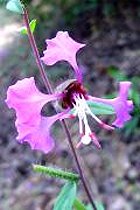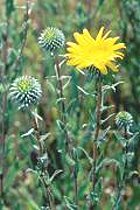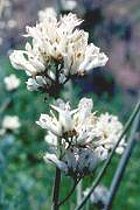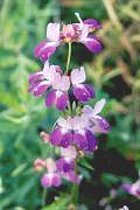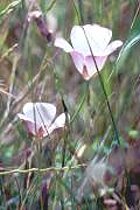-
oakes'ii: named for botanist William Oakes (1799-1848). He was born in Danvers, Massachusetts, and entered Harvard University in 1816, graduating with a BA degree in 1820. He studied law for three years with Leverett Saltonstall (1783-1845), of Salem, Mass. While a student he took an interest in botany and eventually devoted all his time to it. The White Mountains was the area he was most interested in. In 1824 he moved to Ipswich and began practicing law, but continued that for only a short time, being drawn instead to natural history. In 1842 he was asked to write a brief description of the flora of the White Mountains for a geological survey report on New Hampshire, and he expended much energy on this project for the rest of his life. He corresponded with George Engelmann, Asa Gray and John Torrey. The commonly given story is that he drowned after falling off a ferryboat between Boston and East Boston, but at least one source suggested that his death was not an accident. A webpage entitled "Biographies of people who contributed to the Putnam Museum Herbarium" on the Plants of Iowa website includes this: "The untimely demise of William Oakes in 1848 was a grand loss to botany and the Ipswich community in general. The events leading to that fateful Monday remain a mystery, but Mr. Oakes either fell or leapt off the East Boston Railroad ferry and drowned in Boston Inner Harbor. According to Thompson (1853) [in a source I can't access] 'He was drowned on the 31st of July, 1848, while passing from Boston to East Boston, under circumstances which left it doubtful, whether by accident, or in a temporary fit of insanity, to which he was subject.' A report in 'The Liberator' stated that '...while in the ferry boat about a third of the way over, he walked off the stern of the boat and immediately sank and was drowned. He had weights of shot under both arms... The body was recovered the day after." Actually he had purchased just before boarding four lbs of one kind of shot and six lbs of another kind that he had in his pockets, which weight caused him to sink quickly. The American Journal of Science and Arts (1849) contains an extensive obituary by someone only identified as A. Gr., likely to be Asa Gray, which says that he had been unwell the previous week and had been subject to sudden attacks of vertigo, that he had taken no breakfast that morning and was exhausted by walking in the heat of the day, and that he was seen sitting or standing near the stern where there was no barrier just before he went into the water. At this far remove it is akmost certainly impossible to say exactly what happened. Much of his rich herbarium was sent to William Sullivant and Edward Tuckerman for study, the latter of whom named the genus Oakesia in his honor. (Photo credit: University of Wisconsin)
-
ob-: prefix indicating characteristic of being inversed or reversed.
-
obclava'tus: club-shaped but attached by the thicker end, derived from the Latin word clava "club," and the prefix ob-, meaning inversed or reversed, and meaning "club-shaped. "
-
obcon'ica: shaped like an inverted cone.
-
obcorda'tum: inversely cordate, with the point of attachment at the
narrower end.
-
obispoen'se/obispoen'sis: of or from San Luis Obispo Co.
-
oblanceola'tum/oblanceola'tus: having an oblanceolate shape.
-
oblit'erum/oblit'erus: from the Latin oblitteratus, "erased from memory, forgotten, suppressed." David Hollombe
sent me this note: "Obliterus (originally Desmazeria oblitera)
doesn't seem to be a correct classical Latin form, but oblittera means
forgotten or 'caused to be forgotten.' [William Botting] Hemsley didn't
give a derivation but he described it from the Island of St. Helena,
where only a single plant of the species had been found. Like many
islands, St. Helena had been stocked with goats, with predictable
results for the native plant life. Hemsley noted 'It is possible that
the St. Helena plant may be a stray introduction from the Cape of
a species which is rare and local there. At the same time it was collected
in a remote part of the island, where one would little expect to find
a solitary introduced plant.' As it turned out, it was a stray from
South Africa."
-
oblon'ga/oblon'gum/oblon'gus: oblong.
-
oblongifo'lia/oblongifo'lius:
with oblong leaves.
-
oblonga'ta: same as oblonga above.
-
obnup'ta: from the Latin obnuptus, meaning 'veiled' or 'covered' and the application to the plant is possibly to the partial sheathing of the leaf blade. Carex obnupta is the only taxon in California with this epithet. Little available to explain the meaning of this epithet or how it relates to the species in question. The Dictionary of Word Roots and Combining Forms gives "reversed or against" as the meaning of ob-.
-
obova'ta/obova'tum: inverted ovate, that is,
egg-shaped with the broader end uppermost.
-
obscu'ra/obscu'rus: dark, dusky, indistinct,
uncertain, from obscurus, "shadowy, indistinct."
-
observator'ium: named for the type locality of Mt. Hamilton, site of U.C.'s
Lick Observatory.
-
obtu'sa: blunt, dull, dimmed, rounded, obtuse, from the Latin obtusus, "blunt."
-
obtusa'ta/obtusa'tum/obtusa'tus: blunted.
-
obtusiflor'a/obtusiflor'um: blunt-flowered.
-
obtusifo'lia/obtusifo'lium/obtusifo'lius:
obtuse- or blunt-leaved.
-
obtusilo'ba/obtusilo'bus: bluntly or obtusely lobed.
-
obtusiplica'tum: possibly derived from the root words obtusus for "obtuse
or blunt" and plico, "pleated, folded," of unclear application.
Erodium obtusiplicatum is a synonym of Erodium brachycarpum.
-
ocella'ta/ocella'tum:
with an eye, having a spot enclosed within another spot of a different
color. The Latin ocellus means "a little eye," and ocellatus means "spotted."
-
occidenta'le/occidenta'lis:
from the west, western.
-
ochrocen'trum: with an ochre-colored center, from the Greek ochro, "yellow-ochre," and -centro or -centrum. "the center."
-
ochroceph'alum: with an ochre-colored head.
-
ochroleu'ca: yellowish-white, buff-colored, the color
of the flowers, from the Greek ochro, "yellow-ochre," and leukos, "white, bright."
-
ochropet'alus: with pale yellowish petals.
-
octoflor'a: eight-flowered.
The taxon in California with this epithet is Festuca octoflora, commonly called eight-flower frescue, from the average number of florets in a head.
-
ocula'tum: with an eye, or provided with a circular patch of color, from the Latin ocellus, "a little eye."
-
ocymo'ides: resembling the genus Ocimum, basil, whose name comes
from the ancient Greek name okimon used by Theophrastus and
Dioscorides for the aromatic herb.
-
-odes: like, resembling, e.g. sarcodes, "flesh-like,"
physodes, "bladder-like," and tephrodes, "ash-like."
-
odontolep'is: tooth-scaled, from odonto, "a tooth," and lepis, "a scale."
-
odontolo'ma: from odonto, "a tooth," and loma, "hem or fringe," hence tooth-margined, for the leaves.
-
Odontosto'mum: from the Greek odontos, "tooth,"
and stoma, "mouth," referring to the shape of the
staminodes. The genus Odontostomum was published by John Torrey in 1857.
-
odora'ta/odora'tum/odora'tus:
fragrant, sweet-smelling, perfumed, from Latin odoratus, "fragrant."
-
Oe'dera/oe'deri/oederia'nus: named for Georg Christian Edler von Oldenburg Öder (Oeder) (1728-1791), a German-Danish physician, economist, social reformer, professor of botany in Copenhagen, and in 1753 the founding author of Flora Danica, a massive work initially designed to cover all plant species in the crown lands of the Danish king, including Norway with its North Atlantic dependencies Iceland, the Faroe Islands and Greenland, which was only completed 153 years later. He studied medicine at the University of Göttingen under Albrecht von Haller who in 1751, after he had been practicing medicine in the town of Schleswig, persuaded King Frederick V to appoint him as professor botanices regius (Royal Professor). He soon established a botanical garden and began work on the Flora Danica. Öder served on many commissions and was involved in agrarian and social reforms. Because of the crisis in state finances and the strengthening of anti-enlightenment and anti-German conservative circles around 1771, Öder lost his professorship, and this was the period when Christian VII's mental illness became a state crisis, and the country was basically taken over for a couple of years by his royal physician Johann Friedrich Struensee who had an affair with the queen and in 1772 was arrested and executed. Two years before Öder's death he was ennobled by Holy Roman Emperor Emperor Joseph II. The genus Oedera was published by Carl Linnaeus in 1771.
-
Oemler'ia: named for Augustus Gottlieb Oemler
(1773-1852), a German naturalist at Savannah, Georgia, who corresponded
with Gotthilf Muhlenberg and collected in Sweden in 1837. The Dictionary
of American Biography, Vol. 7, gives the following: "Augustus
Gottlieb Oemler was born in Hettstedt, Germany, son of a Lutheran
pastor, a direct descendant of Nicholas Oemler, who married Martin
Luther's sister, and to whom Luther dedicated his translation of the
Bible. Augustus came to America when he was about eighteen and settled
in Savannah, Georgia. He was a pharmacist, botanist, and entomologist."
His great-great-granddaughter Elizabeth informed me that he was nominated
to the National Academy of Sciences in Philadelphia and his scientific
work was well known in his time (Pers. comm.). Apparently, he was
the first to collect the species Oemleria cerasiformis, and
that's why it bears his name. The library at Haverford College in
Pennsylvania houses a collection of his correspondence. The genus Oemleria was published by Heinrich Gottlieb Ludwig Reichenbach in 1841.
-
Oenan'the: from the Greek oinos, "wine,"
for a plant smelling of wine, and the ancient Greek name for some
thorny plant. The genus Oenanthe was published by Carl Linnaeus in 1753.
-
Oenother'a: one source says that this name derives from the Greek oinos, "wine," and thera, "to imbibe," because an allied European plant was thought to induce a taste for wine. However, Stearn's Dictionary of Plant Names gives an alternate meaning for thera as "booty," but also suggests that Oenothera could be a corruption of the Greek onotheras from onos, "ass," and thera, "hunting, chase, pursuit" or ther, 'wild beast." The root ther also can have the meaning of "summer." It has been stated as well that the name Oenothera comes from the Greek oinotheras or onotheras for a plant whose roots smell of wine. In Latin, oenothera apparently means "a plant whose juices may cause sleep," and this may be derived from the idea that drinking wine may cause people to be sleepy. FNA says: "Greek oinos, wine, and thera, seeking or catching, alluding to roots of some unknown plants possessing perfume of wine, perhaps misapplied by Linnaeus." Wikipedia provides this: " The modern name Oenothera was published by Carolus Linnaeus in his Systema Naturae. Its etymology is uncertain, but it is believed to be derived from the Greek words oinos thera, 'wine seeker'." What any of this might have to do with the actual plant is unexplained. The genus Oenothera was published by Carl Linnaeus in 1753 in his Species Plantarum.
-
oerstedia'na/oerstedia'num: named for Anders Sandøe Ørsted (1816-1872), a Danish botanist, mycologist, zoologist
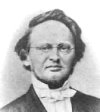 |
|
and marine biologist. He was born in Rudkøbing, Langeland, Denmark. JSTOR says that he “worked as a teacher in Copenhagen from 1839-1844 before making a trip to the West Indies and Central America in 1845-1848. Staying six weeks in Jamaica he collected plants alongside the Scots Gilbert McNab and James Macfadyen and ascended the Blue Mountain Peak. He also collected extensively in Nicaragua and Costa Rica, building up such an expertise in the region that Francis Whittier Pennel in 1946 called him 'the most important botanist of Central America.' |
Returning to Europe Oersted took up work as a lecturer in botany at the University of Copenhagen, which granted him a PhD in 1854. He was later appointed professor [a post he held until 1862]. He published many papers on his botanical findings in Central America and the West Indies, being especially interested in the Acanthaceae and Fagaceae families. His major work L'Amérique Centrale was published in 1863. He also wrote articles on Danish and arctic nematodes, marine algae and plant-parasitic fungi.” He died in Copenhagen.
-
oetting'eri: named for Frederick W. Oettinger (1946?- ), author of The
Vascular Plants of the High Lake Basins in the Vicinity of English
Peak, Siskiyou County, California, which was a masters thesis at Claremont Graduate School in 1975. He collected in the Marble Mountain Wilderness area and the Salmon Mountains beginning in 1967 and records of his collections are at Humboldt State University. He also collected with Robert Thorne. A Fred Oettinger (presumably the same individual) is listed as a research assistant on the staff of Rancho Santa Ana Botanic Garden along with Robert Thorne who was listed as taxonomist and director of the herbarium. The journal Aliso in Vol. 8, Issue 1, 1973, says this: "In the summers of 1967, 1968, and 1969 Frederick W . Oettinger, at that time a graduate student in botany at Claremont, botanized intensively an area covering the high lake basins in the vicinity of English Peak in the Marble Mountain Wilderness Area of the Salmon Mountains, western Siskiyou County, California. Altogether Mr. Oettinger's collections numbered about 1,500, which were taken largely between elevations of 4,500 and 7,300 ft. These plants are now being readied for insertion into the Botanic
Garden Herbarium and duplicates will be distributed to other institutions. Among the plants to which Mr. Oettinger gave particular study is a Trillium of the T. ovatum complex and for which we now propose the sub-specific name oettingeri:" Oettinger collected the type specimen in July 1967. Another source reports that he was a Senior Botanist at the UC Berkeley Botanical Garden in 1971 and refers to him as Billy, a clue that his middle name may have been William. A Frederick W. Oettinger is listed as a co-author with Robert A. Bye of Vascular Flora of Onondaga County, New York, published in 1969, but this person was born in 1925 and apparently no relation. There is a dearth of information about the life of the California Oettinger, especially his early years, and I can find nothing about the period of his later life from the early 1970s on, except a reference in the Santa Rosa Democrat David Hollombe sent me that refers to him as a massage therapist and gardener from Santa Rosa. Trillium ovatum ssp. oettingeri is the only taxon in California named for him.
-
officina'le/officinal'is: the word officinalis literally means “of or belonging to an officīna,” the storeroom of a monastery, where medicines and other necessaries were kept. Officīna was a contraction of opificīna, from opifex, “worker, maker, doer,” from opus, “work,” and - fex or- ficis, “one who does,” from facere, “to do or perform.” When Linnaeus invented the binomial system of nomenclature, he gave the specific name officinalis, in the 1735 edition of his Systema Naturae, to plants (and sometimes animals) which had an established or supposed medicinal, culinary, or other use.
-
-o'ides: from the Greek oeides, "like something else,"
(e.g. betuloides, "like Betula, the birch"; staticoides,
"like the statice"; ambrosioides, "like ambrosia";
ericoides, "like Erica"; gilioides, "like Gilia";
epilobioides, "like Epilobium," etc.).
-
-oid'eus: same as -oides.
-
ojaien'sis: of or from the region of Ojai, California.
-
olanchen'se: named for Olancha Peak in Tulare County.
In California there is Eriogonum wrightii var. olanchense, commonly called Olancha Peak buckwheat, endemic to the state with a rare plant rank of 1B.3.
-
O'lea: a Latin name for an important fruit tree, the olive, known
from antiquity as a symbol of peace and good will. The genus Olea was published by Carl Linnaeus in 1753.
-
olean'der: derived from the Italian oleandro in apparent reference to the olive-like leaves.
-
-olens: a suffix from Latin oleo, "smell, emit an odor," e.g. beneolens, "good-smelling," suaveolens, "sweet-smelling," graveolens, "strong- or ill-smelling."
-
-olen'tum/olen'tus: a suffix used to indicate an abundance of, same
as -ulentum/-ulentus (e.g. vinolentus, "full of wine").
-
olera'cea/olera'ceus:
oleraceous, resembling garden herbs or vegetables used in cooking.
-
oleum: oil, from olea, "olive."
-
oligan'tha/oligan'thus: producing few flowers, from the Greek oligos,
"few," and anthus, "a flower."
-
oligocar'pus: having few fruits.
-
olig'odon: few-toothed.
-
Oligo'meris: from the Greek oligos,
"few," and meris, "part or parts." The genus Oligomeris was published by Jacques Cambessèdes in 1844.
-
oligophyl'la/oligophyl'lus: having few leaves.
-
oligosper'ma/oligosper'mum:
having few seeds.
-
oliva'ceous/oliva'ceum: greenish-brown, olive-colored, from Latin olivaceus, "olive-green."
-
ol'ive-brown'iae: named for Olive Norton Brown Smith (Mrs. Arthur I. Brown, Mrs. Charles Piper Smith) (1886-1961).
-
ol'ive-nortoniae: same as previous entry.
Both this entry and the previous one refer to names published by Charles Piper Smith, in 1948 for presumably the same plant.
-
oli'veri: named for Joseph Campbell Oliver (1836-1925).
-
oliv'iae: named for Olive Lucy Eddy Orcutt (Mrs. Charles R. Orcutt) (1857-1962). She was born in New York City and attended the University of Michigan and in 1882 became the first woman to graduate U.M.’s Homœopathic Medical College with a doctor of medicine degree in 1882. Later that year she moved to Pasadena, California to live with her sister. On 27 September 1892, in Los Angeles, she married Charles Russell Orcutt in Los Angeles with whom she had four children. Mrs. Olive Orcutt established a medical practice and, in true Orcutt fashion, published Out of Doors For Women (1893-1896), a monthly magazine that concentrated on floriculture but included articles on travel, outdoor activities, along with fiction, editorials, and other matters of interest to women.
-
Ol'neya/ol'neyi: named for Stephen Thayer Olney (1812-1878),
a Rhode Island botanist and woolen manufacturer. "Stephen T.
Olney was born on Feb. 15, 1812, in Burrillville, Rhode Island, and received
his education in Providence. He started work in the counting
house of Isaac B. Cooke & Co., which was probably located in Augusta,
Georgia. Later he returned to the Providence area and started
the Wauskuck Co., a woolens firm, with Jesse Metcalf. The business
made Olney a wealthy man, and he devoted some of his wealth to the
pursuit of his botanical interests. He published a catalogue
of Rhode Island plants in connection with the Providence Franklin
Society in 1845, with further additions in 1846-1847. He made
collections of algae from 1846 to 1848 that served as the basis for
a list of Rhode Island algae published in 1871. He became especially
interested in the study of Carex and became an expert
in that area. His publications on Carex include the Carex section of Sereno Watson's Botany (1871) in the Report of the
Geological Exploration of the 40th Parallel which was led by Clarence King.
He built up a private herbarium and botanical library and carried
on a broad botanical correspondence. In his later years, Olney went into a decline. William Whitman
Bailey wrote that he "was an invalid and incapacitated for business
during the last years of his life," and Asa Gray wrote that the end
of his life was "obscured and afflicted by mental trouble." Olney
died a bachelor on July 27, 1878. He left his herbarium, library
and correspondence to Brown University and also gave substantial sums
of money toward botanical studies at Brown. The genus Olneya was published by Asa Gray in 1854.
-
ol'neyae: named for Mary Packham Olney (Mrs. Cyrus Olney) (1824-1903), an American malacologist who was the president of the conchological section of the Rochester Society of Natural Sciences. She was born an Olney in Rhode Island and married her father's cousin who was also an Olney. She was a member of the American Association of Conchologists. She died in Spokane, Washington.
-
Olsyn'ium: a name applied by C.S. Rafinesque who "explained Olsynium as "hardly united" referring to the stamens.
He didn't explain what Greek root he used to indicate 'hardly,'"
(from David Hollombe). The Dictionary of Word Roots gives the
meaning of the Greek prefix ol- as "whole or entire."
The Greek prefix syn- means "together," and the prefix
-ium usually means something like "characteristic of."
The genus Olsynium was published by Constantine Samuel Rafinesque in 1836.
-
olym'picum: of Ulu Dagh aka Mount Olympus in northwestern Turkey.
-
Oncosi'phon: from the Greek onkos,
"bulb, mass," and siphon, "tube," alluding
to the tube of the corolla. The genus Oncosiphon was published by Mari Källersjö in 1988.
-
oneill'ii: named for Hugh Thomas O'Neill (1894-1969), distinguished plant taxonomist and plant collector in the Bahamas, Central America, Mexico and Canada. He was director of the LCU Herbarium at the Catholic University of America in Washington, D.C. He collected 8,000 herbarium specimens from Belize, Guatemala and Nicaragus, and subsequently published a paper on the Cyperaceae of the Yucatan Peninsula. He also directed the dissertation of Brother B. Ayres in 1946 of Cyperus in Mexico. He had several plants named for him.
-
Onobry'chis: a genus of species called the sainfoins, the generic name of which comes from the Greek onos, "an ass, donkey" and bryche, "gnashing, bellowing" from brycho,
"to eat greedily or avariciously." Wikipedia says Onobrychis means "devoured by donkeys," referring to sainfoin's good properties as a forage plant for large mammalian herbivores." And sainfoin is derived from the Old French sain foin, for "healthy hay." The genus Onobrychis was published by Philip Miller in 1754.
-
Onon'is: the classical Greek name used by Pliny for the restharrow,
one of several Old World plants having woody stems, axillary pink
or purplish flowers, and trifoliate leaves with dentate leaflets. Wiipedia says that "the English common name 'restharrow' comes from the plant's propensity to stop horse-drawn farming implements [like plows and harrows], with its hard, woody roots." The genus Ononis was published by Carl Linnaeus in 1753.
-
Onopor'dum: a name for Scotch or cotton thistle taken from the Greek
name onopordon from onos, "an ass," and porde,
"fart," according to Stearn's Dictionary of Plant Names a supposed reference to its effect on donkeys. The genus Onopordum was published by Carl Linnaeus in 1753.
-
onus'tus: from the Latin onustus, "loaded down, burdened."
-
onycen'se: of or from Onyx Peak in eastern Kern County.
The taxon Galium angustifolium ssp. onycense is called Onyx Peak bedstraw.
-
oocar'pus: with fruit like an egg, from the Greek oon, "an egg."
-
ooph'orus: egg-bearing, for the large pods.
-
opa'cus: opaque, from the Latin opacus, “shaded, shady, dark.”
-
ophiochi'lus: from the Greek ophis for "snake or serpent,"
and cheilos, "a margin, lip or brim." The authors
of Ceanothus ophiochilus compared the edges of the leaves to
the pattern of scales on a snake's lips.
-
Ophioglos'sum: from the Greek ophis,
"a snake," and glossa, "a tongue," alluding
to the slender fertile leaf spike. The genus Ophioglossum was published in 1753 by Carl Linnaeus.
-
ophit'idis: derived from ophite, from Latin and Greek ophites meaning serpentine (stone) or snakelike. In geology an ophite is any of various usually green and often mottled or blotched rocks (as a serpentine or serpentine marble), The species which bears this
name, Ericameria ophitidis, is called serpentine goldenbush, and specific name is also on Calamagrostis ophitidis. called serpentine reedgrass.
-
ophthalmo'ides: from the Greek ophthalmos, "eye,"
and the - oides suffix indicating resemblance.
-
op'leri: named for Andrew Butler Opler (1958?- ), who owns a 40-acre parcel of land in Santa Cruz County where the bulk of the population of Cupressus abramsiana ssp. opleri resides.
-
oppositiflor'a: with flowers opposite to each other.
-
oppositifo'lia: with leaves opposite
to each other.
-
-ops/-opsis: indicates a resemblance, as for example Coreopsis,
"resembling a bug," or "Echinops," resembling
a hedgehog or sea-urchin.
-
opta'tus: according to Gledhill, from the Latin optatus, for "longed for, desired," and Wiktionary says that it is the perfect passive participle of opto, “choose, select.”
-
Opun'tia: a Greek name used by Pliny for some plant which grew around the town of Opus in Greece. In 1601 Philemon Holland translated from Pliny's The History of the World, Commonly Called The Natural History of C. Plinius Secundus, "About the city of Opus this an herbe called Opuntia which men delight to eat; this admirable gift the leafe hath, that if it be laid on the ground it will take root and there is no other way to plant the herbe and maintain its kind." Then in 1855, the John Bostock and Henry T. Riley translation of the same passage was "In the vicinity of Opus there grows a plant which is very pleasant eating to man, and the leaf of which, a most singular thing, gives birth to a root by means of which it reproduces itself." Pliny got his information from Theophrastus, and according to David Hollombe, either he was the one who added the name Opuntia or that was added by someone else who copied the manuscript later. The Jepson eflora suggests that it might come from the Papago name opun for this food plant. The genus Opuntia was published by Philip Miller in 1754.
-
orbicular'is: see orbiculata below.
-
orbicula'ta/orbicula'tus: round and flat, disk-shaped, from the Latin for round or circular-shaped.
-
Orcut'tia: see following entry. The genus Orcuttia was published by George S. Vasey in 1886.
-
orcut'tii/orcuttia'na/orcuttia'num/orcuttia'nus:
named for Charles Russell Orcutt (1864-1929) of San Diego, who
 |
|
collected plants and studied the natural history of the southern Colorado Desert.
He was born in Vermont, the youngest of five sons, to a father who
was a farmer and horticultural enthusiast and a mother who was an
accomplished poet. Three of his older brothers died before he was
born. Charles did not go to school, but he was educated by his parents.
By the time he was 11, he was much into collecting, and he displayed
a collection of 202 varieties of beans at the annual county fair in
Woodstock, Vermont. At 13 he began his botanical collecting in earnest,
gathering all |
different types of wood, nuts and seeds. In 1879, his
family relocated to the San Diego area, where he accompanied his father
on many expeditions throughout the region. He traveled with his father
and the eminent Charles Parry to Ensenada, and it was on this trip
that he learned the art of proper scientific collecting. From that
year until 1919 he collected in Baja California and was the first
botanical collector to survey that area. In 1884, he began to write
and publish The West American Scientist, a unique journal in
the west, and continued to produce it until 1919. The year 1892 was
marked both by the death of his father, and by his marriage to Olive
Eddy (see oliviae), a young doctor from Michigan. For their honeymoon, they rode
horseback from Pasadena to San Jacinto and then to San Diego, collecting
plants all along the way. But while these early years were occupied
by his researches and explorations in Baja, they were not limited
to that region, and he journeyed to Texas, Arizona, the mainland of
Mexico, Central America and eventually to the Caribbean. He seemed
particularly interested in cacti, often finding new species and acquiring
the nickname locally of "the Cactus Man." In the late 1920s
he left San Diego and settled in Jamaica, where he collected, continuing
to send specimens back to the Smithsonian and other museums, and was
given funds to work in Haiti, where he was when he died and was buried
at the age of 65. His collections included shells, seeds, living plants,
natural history books, minerals, fossils and herbarium specimens.
He contributed much of his material to various museums such as the
Smithsonian Institution, the Philadelphia Academy of Science, the
American Museum of Natural History, and the San Diego Natural History
Museum. He had desperately wished to make a major contribution to
science, hoping at first to have a museum of his own, and when that
was not to be, he felt that everything he collected should be displayed
in the San Diego Museum, but the officials there did not want everything
he sent them, which was a source of embitterment to him. Because he
had donated so much to so many different institutions, his collections
were scattered around, and so his body of work does not reside in
one location as he had wanted. Nevertheless, he did make a tremendously
significant contribution to botany and natural history, and was rewarded
by having his name assigned to one genus and many species of plants.
-
ord'ii: named for physician and surgeon James Lycurgus Ord (1823-1898), who
was born in Washngton, DC, and
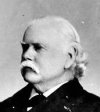 |
|
attended Georgetown College 1835-1837. After spending time in Michigan
and Philadelphia, where he graduated from the Medical College of the
University of Pennsylvania, he was a civilian contract surgeon for
the US Army and was stationed in the Arizona Territory during the
1880s. He spent the entire year of 1884 at Fort Mohave close to the
California border and later settled in California. He was supposedly
the grandson of King George IV of England and his wife Mary Anne Fitzherbert. Ford Ord in California is named for one of his brothers, Major-General
Edward |
Otho Cresap Ord, a Union officer during the Civil War, and
apparently the creator of the first map of Los Angeles in 1849. A
second brother, Placidus, became for a short time a member of the
Michigan legislature, and a third, Robert Brent Ord, was a judge and
landowner in Santa Barbara, and is credited with having brought the
first avocado trees into California, thereby beginning the commercial
avocado industry. He also had three other brothers and a sister. Thanks
to Nina Robbins for sending me the following citation referring to Eriogonum ordii in the Proceedings of the American Academy
of Arts and Sciences, vol. xxi, 1886: "On sand-dunes near
Fort Mohave in western Arizona; collected by J.G. Lemmon in April,
1884, and at his suggestion named for Dr. J.L. Ord, U.S.A., surgeon
at the post, through whose aid Mr. Lemmon's collections were made
in that region." It was named by Sereno Watson (1826-1892) who
was a contemporary of Ord's and Lemmon's. He was one of the oldest members of the Society of California Pioneers. He died of heart disease near Hagerstown, Maryland. (Photo credit: Find-a-Grave)
-
orega'na/orega'num: of or from the state of Oregon, or the old Hudson's
Bay territory of Oregon, which included the present-day states of
Oregon and Washington.
Not surprisingly there are almost a couple of dozen taxa in California with one or the other of these two epithets.
-
oregonen'se/oregonen'sis: see oregana above.
-
oregon'is: see oregana above.
-
Oreocar'ya: from the Greek oros or oreos, "mountain," and karyon, "a nut," in reference to the montane, often high elevation habitats of members of this genus. This is a former genus name published by Edward Lee Greene in 1887 which has now been resurrected.
-
oreochar'is: presumably from Greek oros or oreos, "mountain," and charis, "delight, grace, beauty."
-
Oreona'na: from the Greek oreos, "mountain,"
and nannos, "dwarf," which could allude to a dwarfism
of species due to its mountain habitat. The genus Oreonana was published by Willis Linn Jepson in 1923.
-
oreo'phila: mountain-loving.
-
Oreostem'ma: from the Greek oros, "mountain," and stemma, "a crown or garland." The genus Oreostemma was published in 1900 by Edward Lee Greene.
-
ores'tera: from the Greek oresteros, "of the mountains,
dwelling in the mountains."
-
oric'ola: some sources say that this is from Greek ori, "mountain,"
and -cola, "loving or inhabiting," thus "living in
the mountains," but others such as the Missouri Botanical Garden website A Grammatical Dictionary of Botanical Latin suggest that it might be from the Latin ora, meaning "edge or coast," thus shore-dwelling, rather than Greek oreos, mountain, and this seems logical since this is a coastal species.
-
orienta'le/orienta'lis:
eastern.
-
origanifo'lia: with leaves like those of marjorum or Origanum majorana.
-
Origa'num: Umberto Quattrocchi says: "Ancient classical Greek
name, origanon, oreiganon, origanos, oreiganos,
possibly from the Greek oros, "mountain," and ganos,
"beauty, brightness, ornament, delight," Latin origanum, origanon and origanus for the plant wild-marjorum."
The genus Origanum was published by Carl Linnaeus in 1753.
-
-orius: a Latin adjectival suffix indicating capapility, action
or function (e.g. tinctorius, "used in dying," from tingere,
"to soak in color").
-
ornatis'sima: very showy.
-
orna'ta/orna'tus: ornate, from Latin ornatus, "showy, ornate or decorated."
-
ornduf''fii: named for American botanist Robert Ornduff (1932-2000). He was director of the University and Jepson
 |
|
Herbaria, director of the University of California Botanical Garden, executive director of the Miller Institute for Basic Research in Science, and chair of the (former) department of botany and professor of integrative biology at the University of California at Berkeley. The Jepson Herbarium website says: “He was born in Portland, Oregon, and attended Reed College, where he received a BA in biology in 1953. He went to New Zealand on a Fulbright scholarship in 1954. In 1955 he received an MS from the University of Washington, submitting a thesis on the biosystematics of |
the Australasian Senecio lautus complex. In 1961 he received his PhD in botany at the University of California, Berkeley, having worked on the biosystematics of the composite genus Lasthenia with Herbert L. Mason as his major professor. After teaching briefly at Reed College and Duke University, he returned to Berkeley in 1963 to fill the vacancy created by Mason's retirement. Ornduff was interested in the systematics of various plant groups, particularly the Asteraceae, Menyanthaceae, and Limnanthaceae. He contributed the treatments of the Oxalidaceae, Limnanthaceae, Lasthenia, and a few small genera of Asteraceae for the 1993 Jepson Manual. He also worked on the population biology of cycads, western American floristics, biogeography, Charles Darwin, and the history of botanical exploration.” Art Kruckeberg, professor emeritus at the University of Washington, Seattle, described him as “one of the treasures of the botanical world, a green-thumb botanist who delighted in growing plants and disseminating his interest to the general public,” and botanist Phyllis M. Faber said of him following his death, "his extensive knowledge and love of the California flora remains unmatched .” "[He] was a very, very caring person and a great teacher who deeply loved and appreciated plants," said Peter Raven, his friend for the past 45 years and director of the Missouri Botanical Garden, an organization dedicated to the study and conservation of the floras of the New World. "This came through in one of his biggest contributions, which was turning the UC Botanical Garden into a world-class garden and a leading place for studying and displaying the unique variety of California plants." In recommending [him] for an Award of Merit by the Botanical Society of America (given in 1993), Sherwin Carlquist, a research botanist at the Santa Barbara Botanic Garden, commented that, even though small in size, the UC Botanical Garden “is without a doubt, the most significant botanical garden in the United States, acre for acre.” (Photo credit: Pacific Horticultural Society)
-
Ornithog'alum: bird's milk. FNA says it derives from the Greek ornis, "bird," and gala, "milk," alluding to the color of the flowers. Wikipedia notes that in some species the flowers look like bird droppings. Another source relates that "The idea of 'Bird’s Milk' has come to symbolize something very rare. The origin of the name has been attributed to old Slavic folk tales, where a beautiful princess tests the ardor and resourcefulness of her suitor by sending him out into the wilderness to find and bring back the one fantastical luxury she does not have: bird's milk." Stearn adds the following: "The bulbs of star-of-Bethlehem (O. umbellatum) are supposed by some to have been the 'dove's dung' of the Bible of which a 'cab' measure [a dry measure of 1.22 L] was sold for a shekel during the Babylonian siege of Jerusalem." The genus Orithogalum was published by Carl Linnaeus in 1753 and is called star-of-bethlehem.
-
Ornitho'pus: resembling a bird's foot, from Greek ornithos, "bird," and -pus, "foot" (pous, "a foot"), referring to the shape of the leaves. The genus Ornithopus was published by Carl Linnaeus in 1753.
-
Ornithostaph'ylos: bird cluster, from Greek ornithos, "bird," and staphyle, "a cluster of grapes," allusion obscure. The genus Ornithostaphylos was published by John Kunkel Small in 1914.
-
Oroban'che: from the Greek orobos,
a kind of vetch, and anchone, "choke or strangle"
because of a parasitic habit, this was the Greek name of a plant that
was parasitic on vetch. The genus Orobanche was published by Carl Linnaeus in 1753.
-
Orochaenac'tis: from the Greek oros, "mountain,"
plus the genus Chaenactis for mountain chaenactis. The genus Orochaenactis was published by Frederick Vernon Coville in 1893.
-
oro'genes: from the Greek oros or oreos, "a mountain,"
the same root as in the word "orogeny" meaning the process
of mountain formation, this taxon is referred to by the Jepson Manual
as mountain phacelia.
-
Orogen'ia: from the Greek oros, "mountain," and genia, "born," or genea "race, family,
tribe." The genus Orogenia was published by Sereno Watson in 1871.
-
oron'tium: the Dave's Garden Botanary website says that this is named
for the region of the Orontes River in Syria, from which came a Greek
name orontion which was applied to some aquatic plant.
-
orta'gae: named for Jesús Gonzáles Ortega (1876-1936), a Mexican botanist, agronomist, engineer, teacher and explorer. He arrived in Mazatlán in 1905 and worked first for the Dirección de Estudios Biológicos and was independently employed. He was a prolific plant collector and amassed some 7,000 specimens from Mazatlán and the Sinaloa region. His numerous publications on the local vegetation covered a range of topics, particularly the Cactaceae and trees of Mexico and the flora of Sinaloa, including a catalogue of common names for this state in 1929 and a contribution to the flora of the Islas Marías (Nayarit). The private collection which he maintained was held at the Preparatory School of Mazatlán after his death, but it has since fallen into obscurity. The 'ae' ending normally indicates that the name honors a woman but there is also a rule that when the honored person's name ends in an 'a,' the name is followed by an 'e.'
-
Orthi'lia: Greek for "straight spiral," referring to a
one-sided floral arrangement. FNA says from the Greek orthos, "straight," and ilium, "side or flank," possibly alluding to the secund inflorescence. The genus Orthilia was published by Constantine Samuel Rafinesque in 1840.
-
ortho-: in compound words signifying "upright or straight."
-
Orthoca'rpus: from the Greek orthos, "straight,"
and karpos, "fruit," hence "straight fruit."
The genus Orthocarpus was published in 1818 by Thomas Nuttall.
-
orthocer'as: from the Greek for "straight,
upright" and "horn."
-
orthophyl'lus: with upright or straight leaves.
-
ortgiesia'na: named for Karl Eduard Ortgies (1829-1916), a German botanist and horticulturist. He was born in Bre-
 |
|
men, the son of a horticulturist who no doubt passed along his passion to Karl. In 1844 he was apprenticed at Handelsgärtnerei H. Böckmann in Hamburg. After three years he was trained by nurserymen in Berlin, Potsdam, Magdeburg, Leipzig, Dresden, Erfurt and Hanover. French Wikipedia says: "In 1848 he joined Andrew Henderson & Co in London, a nursery specializing in conifers. In May, 1849 Otgier joined the Duke of Devonshire, a horticultural enthusiast who owned the imposing estate of Chatsworth House with its beautiful park, and who was an orchid-loving |
collector with a huge greenhouse of exotic plants. It was John (or possibly Joseph) Paxton who had designed the park and estate, and who recommended Otgier to the Duke, so that he would take special care of the specimens of the giant water lily, Victoria Regia, in the greenhouse, which was extremely rare in Europe at the time, and of which only the Royal Gardens at Kew had seeds. In 1849 Ortgies was successful in the first blooming of this species in Europe. He crossed Nymphaea dentata with Nymphaea rubra to obtain the first water lily hybrid, which was illustrated in Flore des serre, vol. 8 (1852-1853) under the name Nymphaea ortgiesiano-rubra (now Nymphaea × ortgiesania). Later, he managed to bloom the Australian species Nymphaea gigantea and to make it produce seeds. Ortgies was deputy director of the botanical journal Gartenflora founded by Eduard von Regel in 1852, and director of the Botanical Garden of Zurich. He was a friend of the botanist Benedikt Roezl. In 1894 he celebrated his 50th anniversary as a gardener and finished his work at the botanical garden in Zurich.
-
-orum: suffix given to a personal name to convert it to a substantival
commemorative epithet when the epithet refers to two or more men or
two or more people of mixed genders, thus Ceanothus hearstiorum,
commemorating the Hearst family.
-
Oryc'tes: from the Greek oryktes, "digger, implement
for digging." The genus Oryctes was published by Sereno Watson in 1871.
-
Ory'za: deriving from ancient words in Latin and Greek for "rice."
The genus Oryza was published by Carl Linnaeus in 1753.
-
oryzico'la: growing in places where rice grows.
-
oryzo'ides: like genus Oryza, rice.
-
-osa/-osum/-osus: a Latin adjectival suffix added to a noun indicating an abundance
or a marked or full development of, e.g. venosus, "full of or marked
by an abundance of veins," from vena, "vein";
argillosum, "full of potter's clay" from argilos;
also spinosa, ramosa, villosa, dumosa, fruticosa, gloriosa, tomentosa, tuberosa, glandulosa, saxosa, glutinosa and others.
-
Osmaden'ia: odor gland, from the Greek osme, "odor," and aden, "gland," alluding to strong-scented, glandular herbage. The genus Osmadenia was published by Thomas Nuttall in 1841.
-
Osmorhi'za: from the Greek osme, "odor,"
and rhiza, "root," meaning "odorous root,"
in reference to the fragrance of the crushed root. The genus Osmorhiza was published by Constantine Samuel Rafinesque in 1819.
-
osoen'sis: of or from the Los Osos Valley, San Luis Obispo Co.
The taxon Arctostaphylos osoensis, the only taxon in California with this specific epithet, is called oso manzanita or Los Osos manzanita.
-
osteosper'ma/Osteosper'mum:
from the Greek osteon, "bone," and sperma,
which in Greek compound words means "seeded", thus meaning
"hard-seeded."
-
osterhout'ii: named for George Everett Osterhout (1858-1937), an American businessman and botanist. He was born
 |
|
in Tunkhannock, Pennsylvania, and later went to Easton, Pennsylvania where he graduated from Lafayette College with a BA degree. He had come under the influence of Thomas Conrad Porter, one of his professors, who had been ordained and encouraged Osterhout to study religion. Although he remained a devout Baptist during his lifetime, he chose to study the law after graduating and was admitted to the Pennsylvania bar. I find no evidence that he ever practiced law. In 1885 he moved to Windsor, Colorado. One source, Aven Nelson, says it was for health reasons, while another, |
Roger Lawrence Williams, avers that it was to pursue a strong desire to study Rocky Mountain plants, inspired by Porter, himself a graduate of Lafayette. Porter had done much fieldwork in connection with the Hayden Survey of 1868-1874, and with John Merle Coulter, who published Manual of the Rocky Mountain Region in 1885, the same year that Osterhout moved to Colorado. He set up a lumber business there and remained for the rest of his life. It was probably around 1893 when he began collecting plants from the Rocky Mountain region and began consulting with professional botanists, especially Aven Nelson of the University of Wyoming, and Per Axel Rydberg. He was married in 1894 at the age of 36. He developed a personal herbarium of over 20,000 specimens, of which 8,330 were from his own collecting. He was also the author of some 44 publications, and was known and eulogized for his refinement, droll humor, integrity, sincerity, modesty and gentleness. No other amateur collector contributed more to the knowledge of Rocky Mountain flora. After his death, all of his specimen sheets were left to the Rocky Mountain Herbarium at the University of Wyoming. Regrettably neither his collection books nor his correspondence were preserved.
-
otayen'sis: of the Otay Mountains.
Taxa with this specific epithet include Arctostaphylos otayensis (Otay Mountain manzaita), Ceanothus otayensis (Otay Mountain ceanothus), and Hosackia crassifolia var. otayensis (Otay Mountain hosackia).
-
otis'ii: named for Ira Clinton Otis (1861-1938), an American botanist and botanical collector for the state of Washington. He was born in Pierce, Wisconsin, and died in Seattle, Washington. He was married in 1885 to Lydia Belle Warren in Pierce, Wisconsin, and was remarried in 1890 to Minnie Jean Soule in Seattle.
-
oto'lepis: "scaly ear," from otos, diminutive of otion, "the ear," and lepis, "a scale."
-
Ottel'ia: from the Malabar, India, name Ottel-ambel used for
an aquatic species Ottelia alismoides. The genus Ottelia was published by Christiaan Hendrik Persoon in 1805.
-
Ott'leya/ott'leyi: named for Alice Maria Ottley (1882-1971), a California botanist,
author of A Revision of the California Species of Lotus (1923).
The genus Ottleya was published by Dmitry Dmitrievich Sokoloff in 1999.
-
-otus/-otum: a Greek adjectival suffix used to indicate resemblance
or possession.
-
Ouris'ia: there is much uncertainty and misinformation regarding the etymology of this generic name. Many websites give the information that the plant was named for a man named Oury or Ouris who was supposed to be the governor of the Falkland Islands. The background of this taxon is that it was collected by the French naturalist Philibert Commerson who accompanied Louis Antoine de Bougainville on his voyage of circumnavigation in 1766–1769. According to Commerson’s label the specimen of Ourisia miltopsis was collected during a landfall in the Strait of Magellan in October, 1767, and named for Oury or Ouris, a retired official of the Malouines (Falkland Islands) with an interest in natural history. This information was repeated by Alexandre Etienne Guillaume de Théis in Glossary of Botany, or, Etymological Dictionary of all names and terms relating to this science (Paris, 1810). One problem with this is that there was no governor of the Falklands named Oury or Ouris (the governor at the time being Felipe Ruiz Puente y Garcia de la Yedra), and another is the fact that the plant was not collected on the Falkland Islands. George Don in A General History of the Dichlamydeous Plants, Volume 4 (1838), says that an Ouris was once governor of the Moluccas in the east Indonesian archipelago, and that Commerson had given the plant to him and used his name. I have no information that there was ever such a governor. Later in the voyage Bougainville did travel to the East Indies and Commerson subsequently left the expedition to botanize on the Ile de France (Mauritius) and Madagascar. It doesn’t make sense to me why he would have named a plant collected in the Strait of Magellan for someone in the East Indies, or why his label would indicate the name of a person he would not meet until much later in the voyage. However, there are other much better candidates for the derivation. A biographical sketch by Val Smith about Commerson (and Ouris) in the Newsletter of the New Zealand Botanical Society, Number 117, September 2014, discusses where this name could have come from. He says: “René-André Oury was clerk/secretary of the company set up by Bougainville to finance and organise the French settlement [in the Falklands], and when the colony was handed over to the Spanish he left the Falklands for South America. He joined Bougainville’s expedition, but stayed behind with Commerson and others at Mauritius on the final leg of the journey. Jean-Francois Oury (1745-1807), an aid-pilot and engineer on Bougainville’s voyage, had also worked for the colony in the Malouines and stayed on to assist the authorities at Mauritius. Ourisia may have been named for either, neither or both of them.” Both men were from Genêts in Normandy and may well have been related. René-André Oury was born in 1738 and died in 1812, but I have no further information about him. Both men died at Mauritius. The genus Ourisia was published in 1789 by Antoine Laurent de Jussieu based on the original description by Philibert Commerson. There was also a genus named Ourisianthus.
-
ovalifo'lium: having oval-shaped leaves.
-
ova'le/ova'lis: oval, broadly elliptic.
-
ova'ta/ova'tum/ova'tus: indicates
that the leaves or some other feature of the plant are ovate-shaped.
-
ovatifo'lia: with ovate leaves.
- o'veri: named for American botanist and professor William Henry Over (1866-1956), botanical collector in Minnesota
 |
|
Minnesota and South Dakota, who was born in Edwards County, Illinois. An article about him by Ann Wilson on the W.H. Over Museum webpage provides this information: “He moved to Minnesota where he was a merchant and later homesteaded in South Dakota. Although Over had only an eighth grade education, his inventive and inquiring mind allowed him to conduct experiments to improve seeds and investigation of fossil remains. He discovered a new fossil species which was named after him, a snail, Pisidium overi, which was found in Deuel County near |
Clear Lake. In 1913, Over moved to Vermillion, S.D., to work in the University of South Dakota Museum. At the time of his employment, the museum was under the direction of the State Geological Survey. For years, the Survey had collected biological and fossil specimens from all over the state. Since there had been no one to properly catalog and display them, most of the specimens remained in their shipping boxes. Over was expected to build a vigorous, modern, and progressive museum that could properly present its holding for public viewing. As curator of the museum, Over had some limited funds and the time to travel throughout the state investigating fossil deposits and archeological sites. He identified numerous prehistoric indigenous village sites and also found and identified a fossil crab which was named in his honor, Dakotacancer overana. Over believed in educating the public. He lectured often, gave guided tours of the museum and wrote extensively. In 1921, with Craig Thomas, he authored Birds of South Dakota. Over continued to write books on the natural history of South Dakota, as well as the archeological investigations that he conducted for the museum. Through those writing and his wide personal contacts in the scholarly community, he became nationally known for his contributions as a naturalist, paleontologist and archaeologist. In May of 1936, President I.D. Weeks (USD) awarded W. H. Over the Doctor of Science degree in recognition of his scholarly and educational contributions to the University and the state. In 1948, after thirty-five years of service to the museum, W.H. Over retired at the age of eighty-two. In 1949, the Board of Regents renamed the University Museum the W.H. Over Museum. After retirement he continued writing and pursued his interest in the history of South Dakota. His last publication was the Life History of Sitting Bull, in 1950.” He also established the University of South Dakota Herbarium to provide faculty, students, and scientists with plant specimens from all counties in South Dakota and adjoining regions in the Plains and Upper Midwest. The collection's focus is the Asteraceae family of specimens collected by Over throughout South Dakota between 1913 and 1949. It is but a small sample of the specimens that Over collected during his career. He was also the author of Wildflowers of South Dakota and Mammals of South Dakota. He was particularly interested in the Arikara peoples of North Dakota and the native peoples of South Dakota. He died in Clay County, South Dakota, February 20, 1956. (Photo credit: W.H. Over Museum)
-
owan'ii: named for Peter MacOwan (1830-1909), a major South African botanist, rector and head of natural sciences
 |
|
at Gill College, Somerset East, South Africa, and father-in-law of Selmar Schonland (founder of the botany department at Rhodes University). He was born in Hull, England, the son of Peter MacOwan, a Wesleyan minister from Scotland. He taught at schools in Bath, Colchester and Leeds, and became first interested in botany, starting a collection of flowers and mosses. In 1857 he graduated with a degree in chemistry from the University of London and became professor of chemistry at Huddersfield College in West Yorkshire. A severe lung condition caused him to |
move with his new wife to South Africa where he accepted the post of principal at Shaw College in Grahamstown. His health improved and he resumed studying botany, being associated with such people as William Guybon Atherstone, Henry Hutton and Mary Elizabeth Bowker (Mrs. Frederick William Barber), and carrying on a correspondence and an exchange of specimens with none other than Asa Gray at Harvard, Sir William Hooker in England, and William Henry Harvey who was working on his Flora Capensis. He was responsible for the formation of the South African Botanical Exchange Society which endeavored to send duplicate specimens of plants abroad in excahnge for specimens from elsewhere. He was appointed head of natural sciences at Gill College in Somerset East, and then director of the Cape Town Botanical Garden and curator of the Cape Government Herbarium. In 1887 he was appointed consultant in economic botany to the Cape government and this began the formal science in South Africa of plant pathology. He was the co-author with Charles Eustace Pillans in 1896 of Manual of practical orchardwork at the Cape. He died in Uitenhage in 1909.
-
Oxa'lis: from the Greek oxys for "sharp,
sour," referring to the pleasantly sour taste of the leaves and
stem. The genus Oxalis was published by Carl Linnaeus in 1753.
-
oxyaden'ia: from the Greek oxys, "sharp,"
and aden, "a gland." Apparently, the term 'gland' is derived from the Latin for nut, and it is in that context that Torrey used it in his description when the basionym ( Quercus oxyadenia) was first published in 1853. He included the following: "Glands about an inch and a half long, tapering to a long sharp point," and he was clearly referring to the acorn.
-
oxycar'pum: from the Greek oxys, "sharp," and karpos,
"fruit."
-
oxygo'na/oxygo'nus: with sharp angles.
-
oxy'meris: with sharp parts.
-
oxyno'tus: pointed on the back.
-
oxy'philum/oxy'philus: loving acid soil.
-
oxyphyl'la/oxyphyl'lus: with sharp-pointed leaves.
-
oxyph'ysus: with pointed bladders, for the fruit.
-
Oxy'polis: another good example of the difficulty of finding out
what some of these names mean: Munz says from the Greek oxys,
"sharp," and polis, "city," of uncertain
application. The Jepson eflora simply gives the definition as "sharp
white," and the Dictionary of Word Roots and Combining Forms does give the Greek root poli as "gray." Southwest Colorado Wildflowers agrees by saying that the root polios stands for gray/white. Quattrocchi on the other hand says the name is from "sharp"
and polos for "axis or pole," referring to the leaves.
Flora Neomexicana says from Greek oxys, "sharp," and polos, "a pivot or axis," thus sharp axis, the allusion unclear. So this is one that will remain argued about. The genus Oxypolis was published by Constantine Samuel Rafinesque in 1825.
-
Oxyr'ia: from the Greek oxys, "sharp or sour," referring
to the sharp or bitter taste of this northern herb with antiscorbutic
properties. The genus Oxyria was published by John Hill in 1765.
-
Oxysty'lis: from the Greek oxys, "sharp,"
and stylis, "column or style." The genus Oxystylis was published by John Torrey and John Charles Frémont,in 1845.
-
oxystylo'ides: resembling genus Oxystylis.
-
Oxyten'ia: from the Greek oxytenes, "pointed" or oxys, "sharp, sour," and tainia, "fillet."
The Southwest Colorado Wildflowers website refers to the root tenia as "ribbon," and says that it alludes to the long, narrow, pointed leaves. FNA also says it refers to the rigid narrow foliage. Oxytenia has only a single species in California, acerosa. The genus Oxytenia was published by Thomas Nuttall in 1848.
-
Oxythe'ca: from oxys, "sharp,"
and theke, "a case or box," in reference to the awned
involucre. The genus Oxytheca was published by Thomas Nuttall in 1848.
-
Oxytro'pis: from oxys, "sharp," and tropis,
"keel," in reference to the beaked flower petals. The genus Oxytropis was published by Augustin Pyramus de Candolle in 1802.
-
Ozomel'is: from Greek ozo, "to smell," and melissa, "honey-bee," for the odor of honey. The genus Ozomelis was published by Constantine Samuel Rafinesque in 1836.
|
